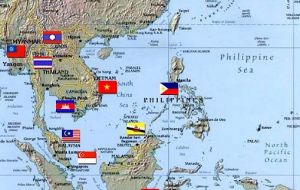MercoPress. South Atlantic News Agency
Asia taking a clear global trade lead over Latinamerica
 Asean countries have a population of 558 million
Asean countries have a population of 558 million The United Nations Economic Committee for Latinamerica and the Caribbean, CEPAL, recommends Latinamerica and MERCOSUR to have closer links with the Association of South East Asian nations, ASEAN.
In a white paper titled "Latinamerica and Caribbean international insertion in 2006; tendencies for 2007", Cepal warns that the proliferation of intra Asian countries trade agreements could affect trade tendencies in other parts of the world including Latinamerica. Following on this recommendation Mercosur has invited Asean member countries to be present at the December 2007 ministerial meeting to be held in Uruguay. First contacts earlier this year helped establish a mechanism of consultations plus economic, trade and investment cooperation. A previous Latam-Asia gathering scheduled in Singapore before December should help to agree on an agenda. Latinamerica exports to Asia mainly commodities while ASEAN sales are concentrated in technology, communications and computer industry goods. Asean countries with a population of 558 million include Brunei, Cambodia, Philippines, Indonesia, Laos, Malaysia, Myanmar, Singapore, Thailand and Vietnam. Cepal points out that ASEAN member country have agreed on a free trade area which originally was announced for 2015 but has now been advanced for 2010, plus similar agreements with Korea next year and Australia and New Zealand also in 2010. Japan which represents 12% of all ASEAN trade, 160 billion US dollars in 2006, has also signed a draft free trade treaty currently under consideration and which contemplates a flat 90% tariff reduction in all products. The agreement could be ready for signing sometime before the end of the year. The European Union and United States are also in negotiations for trade agreements with the Asian group and China is expected to join sometime after 2015 when the country becomes the world's second largest economy. According to the Cepal report ASEAN countries represented 5.5% of all world imports and 6.4% of all global exports. Cepal proposes that Latinamerica adopt an Asian-Pacific strategy with production and export diversification, greater added value to commodities' exports and a closer link between trade and investments.




Top Comments
Disclaimer & comment rulesCommenting for this story is now closed.
If you have a Facebook account, become a fan and comment on our Facebook Page!